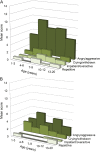Previously unrecognized behavioral phenotype in Gaucher disease type 3
- PMID: 28634598
- PMCID: PMC5458667
- DOI: 10.1212/NXG.0000000000000158
Previously unrecognized behavioral phenotype in Gaucher disease type 3
Abstract
Objective: To provide a comprehensive description of abnormal behaviors in patients with Gaucher disease type 3 (GD3) and relate these behaviors to demographic, neurodevelopmental, and neurologic characteristics.
Methods: Thirty-four Egyptian patients with GD3 (mean age of 7.9 years) were enrolled in the study. They were selected based on parent report and/or physician observation of one or more abnormal behaviors documented in 2 settings and by 2 different individuals and/or by video recording. Behaviors were grouped into 4 categories: Crying/Withdrawal, Impatience/Overactivity, Anger/Aggression, and Repetitive Acts. Baseline and follow-up 6-12 monthly neurologic evaluations included IQ assessment and an EEG. All patients were receiving enzyme replacement therapy (30-60 IU/kg every 2 weeks) and were followed for periods of 3-10 years.
Results: Supranuclear palsy of horizontal gaze, and of both horizontal and vertical gaze, bulbar symptoms, seizures, convergent strabismus, abnormal gait, and neck retroflexion were present in 97.1%, 50%, 55.9%, 29.4%, 29.4%, 20.6%, and 4.4% of patients, respectively. The most abnormal behavioral features were excessive anger (88.2%) and aggression (64.7%), and both were significantly higher in males. Anger/Aggression scores were highly correlated with IQ but not with either EEG/Seizure status or neurologic signs.
Conclusions: We describe behavioral problems with a unique pattern of excessive anger and aggression in patients with GD3. Defining these components using quantitative behavioral scoring methods holds promise to provide a marker of neurologic disease progression and severity.
Figures
References
-
- Abdelwahab M, Blankenship D, Schiffmann R. Long-term follow-up and sudden unexpected death in Gaucher disease type 3 in Egypt. Neurol Genet 2016;2:e55 doi: 10.1212/NXG.0000000000000055. - DOI - PMC - PubMed
-
- Erikson A, Bembi B, Schiffmann R. Neuronopathic forms of Gaucher's disease. Baillieres Clin Haematol 1997;10:711–723. - PubMed
-
- Campbell PE, Harris CM, Vellodi A. Deterioration of the auditory brainstem response in children with type 3 Gaucher disease. Neurology 2004;63:385–387. - PubMed
-
- Altarescu G, Hill S, Wiggs E, et al. . The efficacy of enzyme replacement therapy in patients with chronic neuronopathic Gaucher's disease. J Pediatr 2001;138:539–547. - PubMed
LinkOut - more resources
Full Text Sources
Other Literature Sources

